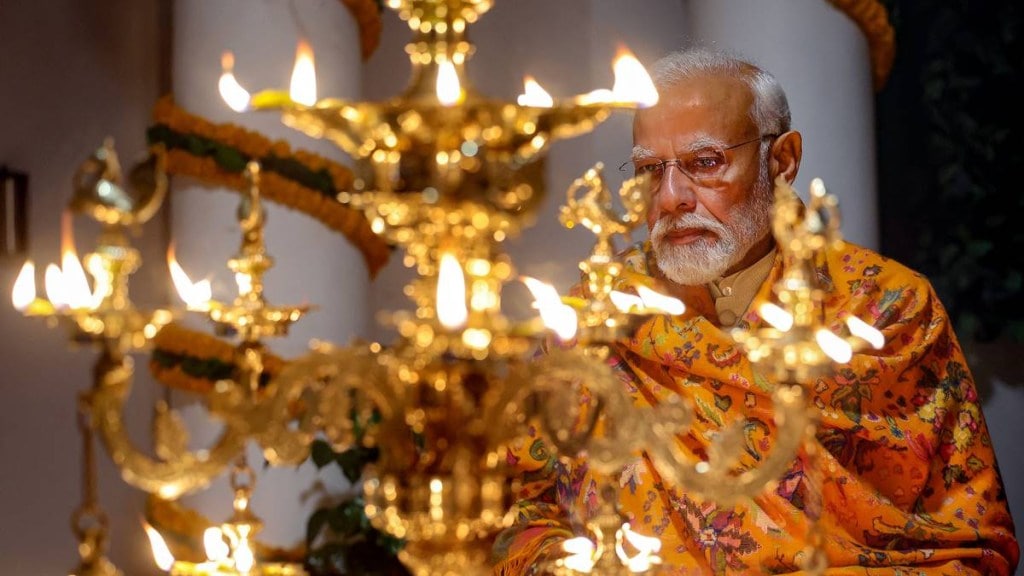Amid an unprecedented religious fervour on Monday, Prime Minister Narendra Modi made an emotional appeal to the nation from the premises of the newly-inaugurated Ram Temple in Ayodhya. Wearing religion on his sleeve, the PM drew a broad canvas linking the construction of the Ram Temple to national development and presented the inauguration as a “solution” against the Opposition’s long-drawn attempts to paint it as a “symbol of dispute”.
“Today, I call upon those who fear unrest to feel it, to rethink. Ram is not the fire that destroys; Ram is creative energy. Ram is not a dispute; Ram is the solution. Ram is not only ours; Ram is for everyone. Ram is not just the present; Ram is eternal,” the PM said in his speech soon after performing the Pran Pratishtha of the Ram Lalla idol at the Ayodhya temple.
Also Read: Modi says Ayodhya Ram Temple marks beginning of new ‘Kaal Chakra’
“Dev se Desh”, “Ram se Rashtra”, the PM said, promising a “new and better chapter” for the country and all its citizens. The optics, symbolism and words of the Prime Minister turned into what has aptly been described as a “Modi Moment”. The construction was inevitable following the Supreme Court’s unanimous order in November 2019. Yet, Modi managed to turn it into an occasion that would come to define his leadership. The ‘Kaal Chakra’, or wheel of time, Modi claimed, had turned irreversibly.
The challenge before the Opposition, or the INDIA bloc to be specific, is multi-faceted. Faced with its own contradictions and struggling to contain troubles over leadership face and seat-sharing, the united Opposition will find it increasingly difficult to counter this overwhelming narrative that the PM has stitched around the Ram Temple.
Also Read: From Babri Masjid to Ram Mandir: Tracing the 500-year-old history of the temple
And the Opposition’s response on the day of the consecration ceremony was striking. An Opposition that had come to identify itself as the voice against the BJP on the Ram Temple issue, and consistently described as a “symbol of communal disharmony”, was seen scrambling to shape up its response. The Congress declined the invitation terming its “BJP-RSS election event” while the Samajwadi Party said it would visit the temple at a later date.
On the other hand, Trinamool Congress’ Mamata Banerjee held a multi-faith rally in Kolkata where she ended up slamming Congress more than the BJP. Elsewhere in the national capital, the ruling Aam Aadmi Party launched a bid to distance itself from the bloc opposed to how the consecration ceremony was held through its own Shobha Yatras, Ram Leela, Sundar Kaand and community kitchens.
Also Read: Ayodhya Ram Mandir opens for public! Check aarti, darshan timings; how to book passes
Each Opposition party has sought to test strategies and figure out what their response to the Ram Temple issue should be. Having spent a good part of their careers since 1992 standing against the Ayodhya movement, they suddenly do not want to be seen as insensitive to the Hindu sentiment. The confusion that the top court’s unanimous verdict sparked within Opposition parties refuses to dial down.
The Opposition’s stand over the decades makes their challenge even more complex. Parties that have opposed the BJP, and accused it of using religion as a political weapon, are now faced with the challenge of a new narrative that blends religiosity with nationalism and adds a layer of nation-building to it. RSS Sarsanghchalak Mohan Bhagwat’s talk of “hosh” (reason) amid the “josh” (passion) and the need to show “restraint” and work towards “resolution of social disputes” came as the cherry on the cake.
Much of the outcome of the Lok Sabha elections this year will depend on how, and if, the Opposition can join forces to come up with a united response to the narrative that the BJP-Sangh has woven together. With the Ram Temple sentiment unlikely to die down anytime soon, expect the Opposition to find itself playing catch-up in a race against time with the BJP miles ahead.

